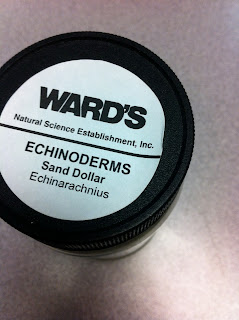Thursday, February 9, 2012
Tuesday, January 24, 2012
Want to Learn More About Echinoderms?
Click here! for informative powerpoint elaborating about all Echinoderms
Monday, January 23, 2012
Dissecting Echinoderms! part 2
Dissecting Echinoderms!



 Oral Side of starfish ^
Oral Side of starfish ^ aboral side of starfish^
aboral side of starfish^Starfish
Asterias rubens
~skeletal plates(ossicles)- provide structure and allow movement, acting as joints
~ampulla-muscular tissue structure that controls the water in the foot and squeezes it out
~pyloric caecum- helps the digestion through absorption.
~pyloric stomach- connects digestive glands
~tube feet-they help the starfish move with suction cups
Video 3
http://www.youtube.com/watch?v=qQrt642LPa8
This video talks about the classification of the phylum Echinodermata as a whole.
Video 2
This video talks about Sea Urchins in the phylum Echinodermata.
Video 1
This video talks about the phylum Echinodermata as a whole.
Tuesday, January 17, 2012
Major Diversities and Classes of Echinoderms
Research Article:
Carbon Impact of Echinoderms
Other Copy of Article
Research Article:
Carbon Impact of Echinoderms
Other Copy of Article
Sarah Champ, Brooke Bode, Lauren Sandstedt
“Echinoderms Contribute To Global Carbon
Sink”
Article Summary
Mario Lebrato, a
Professor at the Leibniz Institute of Marine Science in Germany, recently conducted
a study on the Carbon “sink” or storage of Echinoderms. Lebrato’s findings
were, at best, alarming. Lebrato estimates that Echinoderms (Sea Urchins,
starfish, brittle stars, sea cucumbers, sea lilies, etc.) who inhabit the
seabed contribute over one hundred thousand million kilograms of inorganic
carbon annually. That means Echinoderms could hold the key to mitigating global
warming, but “ocean acidification” and climate change are making oceanic
ecosystems unstable, and could be threatening echinoderms.
Echinoderms,
like many of the calcifying organisms in the ocean, have the ability to convert
carbon from the seawater to storable materials in their bodies. Echinoderm’s
skeletons aren’t comprised of raw inorganic carbon; they have the capacity to
convert and store the carbon as calcium carbonate. What Lebrato and other scientists are investigating is what
happens when the Echinoderms and other “benthos” that inhabit the sea bed die.
When an
Echinoderm dies, typically, their body releases a minute amount of carbon, but
the majority of the inorganic carbon is trapped in the sediment at the bottom
of the ocean. What the authors of this particular article don’t articulate is
what exactly carbon sink and carbon sequestration are. Some carbon sinks
actually have the capacity to sequestrate CO2 emissions from the atmosphere.
What’s alarming
is how little is known about the role of forams and echinoderms in the carbon
cycle. As Lebrato summates,"The scientific
community needs to reconsider the role of benthic processes in the marine
calcium carbonate cycle. This is a crucial but understudied compartment of the
global marine carbon cycle, which has been of key importance throughout Earth
history and it is still at present."
Works Cited
Lebrato,
Mario, and Richard Feeley. “Echinoderms Contribute To Global Carbon Sink.” Science
Daily (Jan. 2010): n. pag. Ebsco Host. Web. 22 Jan. 2012.
<http://web.ebscohost.com/src/detail?vid=5&hid=21&sid=f9902e6c-c93d-48b3-b9af-4a3b4b272c75%40sessionmgr4&bdata=JnNpdGU9c3JjLWxpdmUmc2NvcGU9c2l0ZQ%3d%3d#db=nfh&AN=16PU903800570>.
“What
are carbon sinks?” FERN. EU Environmental Council, 2011. Web. 22 Jan.
2012. <http://www.fern.org/campaign/carbon-trading/what-are-carbon-sinks>.
Subscribe to:
Comments (Atom)






 The urchin's innards are exposed, with the teeth and stomach spilling out.
The urchin's innards are exposed, with the teeth and stomach spilling out.


